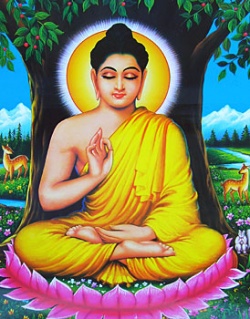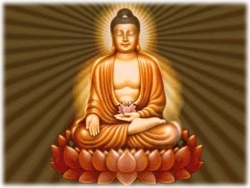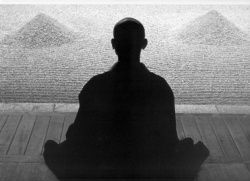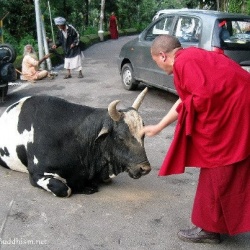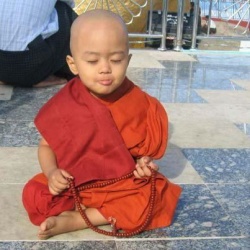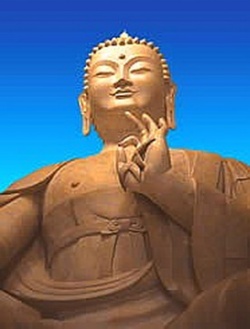Vipassanā
Vipassanā' (Pāli) or vipaśyanā (विपश्यना, Sanskrit, Chn. 觀 guān;Tib. ལྷག་མཐོང་, lhaktong; Wyl. lhag mthong) in the Buddhist tradition means insight into the true nature of reality.
In the Theravadin context, this entails insight into the three marks of existence, the impermanence and unsatisfactoriness of every conditioned thing that exists and non-self.
In Mahayana contexts, it entails insight into what is variously described as sunyata, dharmata, the inseparability of appearance and emptiness, clarity and emptiness, or bliss and emptiness.
Vipassanā is commonly used as a synonym for vipassanā-meditation, in which anapanasati, mindfulness of breathing, is used to become aware of the impermanence of everything that exists.
Vipassanā is commonly used as one of two poles for the categorization of types of Buddhist practice, the other being samatha (Pāli; Sanskrit: śamatha).
This distinction originates in the earliest interpretations of the Sutta Pitaka, not in the suttas themselves.
Samatha is a focusing, pacifying, and calming meditation common to many traditions in the world, notably yoga.
According to the contemporary Theravada orthodoxy, samatha is used as a preparation for vipassanā, pacifying the mind and strengthening the concentration in order to allow the work of insight, which leads to liberation.
Vipassanā-meditation has gained popularity in the west through the modern Buddhist vipassana movement, modeled after Theravāda Buddhism meditation practices, which employs vipassanā and ānāpāna meditation as its primary techniques and places emphasis on the teachings of the Satipaṭṭhāna Sutta.
==Etymology==
Vipassanā is a Pali word from the Sanskrit prefix "vi-" and verbal root paś.
It is often translated as "insight" or "clear-seeing," though, the "in-" prefix may be misleading; "vi" in Indo-Aryan languages is equivalent to the Latin "dis."
The "vi" in vipassanā may then mean to see into, see through or to see 'in a special way'.
Alternatively, the "vi" can function as an intensive, and thus vipassanā may mean "seeing deeply".
A synonym for "Vipassanā" is paccakkha (Pāli; Sanskrit: pratyakṣa), "before the eyes," which refers to direct experiential perception.
Thus, the type of seeing denoted by "vipassanā" is that of direct perception, as opposed to knowledge derived from reasoning or argument.
In Tibetan, vipashyana is lhagthong (wylie: lhag mthong).
The term "lhag" means "higher", "superior", "greater"; the term "thong" is "view" or "to see".
So together, lhagthong may be rendered into English as "superior seeing", "great vision" or "supreme wisdom."
This may be interpreted as a "superior manner of seeing", and also as "seeing that which is the essential nature".
Its nature is a lucidity — a clarity of mind.
Henepola Gunaratana defined Vipassanā as:
Looking into something with clarity and precision, seeing each component as distinct and separate, and piercing all the way through so as to perceive the most fundamental reality of that thing"
== Origins ==
In the sutta pitaka the term "vipassanā" is hardly mentioned:
If you look directly at the Pali discourses — the earliest extant sources for our knowledge of the Buddha's teachings — you'll find that although they do use the word samatha to mean tranquillity, and vipassanā to mean clear-seeing, they otherwise confirm none of the received wisdom about these terms.
Only rarely do they make use of the word vipassanā — a sharp contrast to their frequent use of the word jhana.
When they depict the Buddha telling his disciples to go meditate, they never quote him as saying "go do vipassanā," but always "go do jhana."
And they never equate the word vipassanā with any mindfulness techniques.
According to Gombrich, the distinction between vipassanā and samatha did not originate in the suttas, but in the interpretation of the suttas. According to Henepola Gunaratana;
The classical source for the distinction between the two vehicles of serenity and insight is the Visuddhimagga.
The suttas contain traces of ancient debates about the interpretation of the teachings, and early classifications and hierarchies.
Out of these debates developed the idea that bare insight suffices to reach liberation, by bare insight alone in the Three marks of existence, namely dukkha, anatta and anicca.
This is in contradiction with the Four Noble Truths and the Noble Eightfold Path, in which the Buddhist path starts with insight, to be followed by practices to cultivate the mind and reach Nirvana.
The Sthaviravada emphasized sudden insight:
In the Sthaviravada [...] progress in understanding comes all at once, 'insight' (abhisamaya) does not come 'gradually' (successively - anapurva).
The Mahasanghika had the doctrine of ekaksana-citt; ekaksana-citt, "according to which a Buddha knows everything in a single thought-instant".
The emphasis on insight is also discernible in the Mahayana-tradition, which emphasises prajna:
[T]he very title of of a large corpus of early Mahayana literature, the Prajnaparamita, shows that to some extent the historian may extrapolate the trend to extol insight, prajna, at the expense of dispassion, viraga, the control of the emotions.
Although Theravada and Mahayana are commonly understood as different streams of Buddhism, their practice too may reflect emphasis on insight as a common denominator:
In practice and understanding Zen is actually very close to the Theravada Forest Tradition even though its language and teachings are heavily influenced by Taoism and Confucianism.
The emphasis on insight is also discernible in the emphasis in Chán on sudden insight, though in the Chán-tradition this insight is to be followed by gradual cultivation.
== Practice ==
Vipassanā meditation differs in the modern Buddhist traditions and in some nonsectarian forms.
It includes any meditation technique that cultivates insight including contemplation, introspection, observation of bodily sensations, analytic meditation, and observations about lived experience.
=== Theravāda ===
Vipassanā as practiced in the Theravāda centers on mindfulness of breathing, combined with the contemplation of impermanence.
The underlying principle is the investigation of phenomena as they manifest in the Four Foundations of Mindfulness highlighted in the Satipatthana Sutta:
- kaya (body or breath),
- vedana (feeling or sensation),
- citta (mind or consciousness), and
- dhamma (mind objects).
==== Mindfulness of breathing ====
- See also:Anapanasati
Mindfulness of breathing is described throughout the Sutta Pitaka.
The Satipatthana Sutta describes it as going into the forest and sit beneath a tree and then to simply watch the breath, if the breath is long, to notice that the breath is long, if the breath is short, to notice that the breath is short.
==== Contemplation of impermanence ====
- See also:Sampajañña
By observing the breath one becomes aware of the perpetual changes involved in breathing, and the arising and passing away of mindfulness.
One can also be aware of and gain insight into impermanence through the observation of bodily sensations and their nature of arising and passing away.
Contemplating on these perpetual changes one becomes aware of impermanence, unsatisfactoriness and lack of an inherent, independent essence or self.
==== Relation with samatha ====
In the Visuddhimagga, 40 meditation objects are being mentioned: 10 kasinas, 10 objects of repulsion, 10 recollections, 4 Brahma-vihara, 4 formless states, perception of disgust of food, and analysis of the four elements.
Anapanasatti can be used for both vipassanā and samatha.
Stages in the practice
The Vipassanā practitioner reaches the step where gross bodily sensations (Vedana) dissolve and there is a subtle flow of sensations throughout the body, which is called bhaṅgānupassanā ñāṇa (Sanskrit: bhaṅgānupaśyanājñāna), knowledge of dissolution.
This is an ongoing process, that continues to reveal layer upon layer of mental purification.
The Vipassanā yogi or yogini experiences increasing cessation of cravings (attachments) and aversions (fears), and eventually will reach the step of saṅkhārupekkhāñāṇa (Sanskrit: saṃskāropekṣājñāna), strongly founded knowledge of equanimity of all formations.
In the Theravada tradition, Upekkha or equanimity is a Brahma state.
If the state itself, the acts done that lead to that state, and any cravings are not seen with wisdom, then it does not lead to the attainment of nibbāna but to a new state.
==== Result ====
Vipassanā-meditation is thought to develop insight into the impermanence of all phenomena, and thereby lead to a permanent liberation.
Most Theravādin teachers refer to knowledges evolving during practice.
The meditator gradually improves his perception of the three marks of existence.
Some steps are described as vipassanā jhānas, or simply as knowledges.
===In the Mahāyāna===
Similar to the Theravadan approaches, Mahāyāna vipaśyanā includes contemplation on Buddhist teachings as well as experiential awareness.
The latter is particularly prevalent in East Asian traditions such as Zen.
But in addition and in particular the Mahāyāna practitioner contemplates the two truths doctrine:
the nature of conventional truth and absolute truth.
Through the cultivation of this awareness, one realizes that both self and external phenomena lack an inherent existence and have the nature of emptiness (Skt: śūnyatā).
This is determined by the inferential path of reasoning and direct observation through meditation.
The Mahāyāna also introduced meditation upon visualizations, such as an image of Prajnaparamita in female, deity form, as a way to contemplate Buddhist teachings.
Each component of the visualization evokes a particular teaching and the practitioner then contemplates using a visual symbolic representation.
The polarity of samatha and vipassanā is discernible in the Chinese and Tibetan debates over gradualism or subitism.
Nevertheless, Huineng, sixth patriarch of the Zen, considered the practice cannot be described as gradualist nor subitist, but implies people with more or less clear minds.
==== Inductive and deductive analysis in the Indo-Tibetan tradition ====
It appears that Indian Mahāyāna Buddhism employed both deductive investigation (applying premises to experience) and inductive investigation (drawing conclusions from direct experience) in the practice of vipaśyanā at the level of sūtrayāna,
corresponding respectively to the "contemplative forms" and "experiential forms" in the Theravāda school described above. As scholar Leah Zahler explains,
The practice tradition suggested by the Treasury Abhidharma-kośa .. . — and also by Asaṅga's Grounds of Hearers — is one in which mindfulness of breathing becomes a basis for inductive reasoning on such topics as the five aggregates;
as a result of such inductive reasoning, the meditator progresses through the Hearer paths of preparation, seeing, and meditation.
It seems at least possible that both Vasubandhu and Asaṅga presented their respective versions of such a method, analogous to but different from modern Theravāda insight meditation, and that Gelukpa scholars were unable to reconstruct it in the absence of a practice tradition because of the great difference between this type of inductive meditative reasoning based on observation and the types of meditative reasoning using consequences (thal 'gyur, prasaanga) or syllogisms (sbyor ba, prayoga) with which Gelukpas were familiar.
Thus, although Gelukpa scholars give detailed interpretations of the systems of breath meditation set forth in Vasubandu's and Asaṅga's texts, they may not fully account for the higher stages of breath meditation set forth in those texts. . .
it appears that neither the Gelukpa textbook writers nor modern scholars such as Lati Rinpoche and Gendun Lodro were in a position to conclude that the first moment of the fifth stage of Vasubandhu's system of breath meditation coincides with the attainment of special insight and that, therefore, the first four stages must be a method for cultivating special insight [although this is clearly the case].
As she notes, it appears that only the tradition of deductive analysis in vipaśyanā was transmitted to Tibet in the sūtrayāna context.
This tradition is outlined by Kamalaśīla in his three Bhāvanākrama texts (particularly the second one), following in turn an approach described in the Laṅkāvatāra Sūtra.
One scholar describes his approach thus:
"the overall picture painted by Kamalaśīla is that of a kind of serial alternation between observation and analysis that takes place entirely within the sphere of meditative concentration" in which the analysis portion consists of Madhyamaka reasonings.
Contemporary Tibetan scholar Thrangu Rinpoche explains,
The approach in the sutras . . .is to develop a conceptual understanding of emptiness and gradually refine that understanding through meditation, which eventually produces a direct experience of emptiness . . . we are proceeding from a conceptual understanding produced by analysis and logical inference into a direct experience . . . this takes a great deal of time. . . we are essentially taking inferential reasoning as our method or as the path.
There is an alternative . . . which the Buddha taught in the tantras . . . the primary difference between the sutra approach and the approach of Vajrayana (secret mantra or tantra) is that in the sutra approach, we take inferential reasoning as our path and in the Vajrayana approach, we take direct experience as our path.
In the Vajrayana we are cultivating simple, direct experience or "looking." We do this primarily by simply looking directly at our own mind.
In general there are two kinds of meditation: the meditation of the paṇḍita who is a scholar and the nonanalytical meditation or direct meditation of the kusulu, or simple yogi. . . the analytical meditation of the paṇḍita occurs when somebody examines and analyzes something thoroughly until a very clear understanding of it is developed. . .
The direct, nonanalytical meditation is called kusulu meditation in Sanskrit.
This was translated as trömeh in Tibetan, which means "without complication" or being very simple without the analysis and learning of a great scholar.
Instead, the mind is relaxed and without applying analysis so it just rests in its nature.
In the sūtra tradition, there are some nonanalytic meditations, but mostly this tradition uses analytic meditation.
That is, in Tibet direct examination of moment-to-moment experience as a means of generating vipaśyanā became exclusively associated with vajrayāna.
When vipaśyanā was generated in a sūtrayāna context, it necessarily involved conceptual contemplation of points of doctrine.
One exception to this dichotomy, however, was the approach of Kagyu tradition known as sūtra mahāmudrā, which emphasizes "direct, unmediated experience" which "goes beyond verbalization."
As Zahler noted, the vipassanā "experiential forms" approach advocated in the early suttas and practiced in the Theravāda tradition more closely resembles sūtra mahāmudrā than it does the conventional Tibetan sūtrayāna vipaśyanā.
The only significant difference is that in the sūtra mahāmudrā tradition practice is general preceded by pointing-out instruction.
As scholar Klaus-Dieter Mathes notes, "while ordinary vipaśyanā practice [in the Indo-Tibetan sūtrayāna tradition] requires an analytical or intellectual assessment of emptiness which is mainly based on Madhyamaka reasonings, Bkra shis rnam rgyal,
for example, starts (!) the presentation of vipaśyanā in his Phyag rgya chen po’i khrid yig chen mo with the following pith-instructions:
Assume the same body posture as before (i.e., as in śamatha practice) and gaze straight [ahead] without blinking or shifting. With lucid and non-conceptual śamatha as a basis, one should keep one’s attention vividly present.
In this state look nakedly (rjen lhang gis) into the mind itself to see what shape, colour etc. it has.
This approach is sometimes traced to Sahajavajra’s Tattvadaśakaṭīkā, wherein the author distinguishes his approach to śamatha and vipaśyanā from that featured in the three Bhāvanākrama texts (particularly the second one) of Kamalaśīla.
Sahajavajra notes that whereas in Kamalaśīla's approach vipaśyanā is "produced on the basis of analysis," in his own "it must be directly meditated upon with a non-analytical mind."
=== In Mahāmudrā and Dzogchen ===
Mahāmudrā and Dzogchen use vipaśyanā extensively.
This includes using some methods of the others traditions but also incorporates different approaches.
Like the Mahāyāna they include meditating on symbolic images as contemplations but place a greater emphasis on this form of meditation.
Additionally in the Vajrayāna (tantric) path, the true nature of mind is pointed out by the guru and the practitioner practices with that direct experience as a form of vipaśyanā.
Many Kagyupas, in fact, consider Mahāmudrā (specifically the traditions Jamgon Kongtrul came to characterize as "sutra" and "essence") "not-specifically-Tantric" following the lead of Gampopa, who "distinguishes . . . a path of direct perception from a general Mahāyāna path of inferences and a Vajrayāna path of blessing."
Thrangu Rinpoche describes the approach using a guru:
In the Sūtra path one proceeds by examining and analyzing phenomena, using reasoning.
One recognizes that all phenomena lack any true existence and that all appearances are merely interdependently related and are without any inherent nature.
They are empty yet apparent, apparent yet empty.
The path of Mahāmudrā is different in that one proceeds using the instructions concerning the nature of mind that are given by one's guru.
This is called taking direct perception or direct experiences as the path.
The fruition of śamatha is purity of mind, a mind undisturbed by false conception or emotional afflictions.
The fruition of vipaśyanā is knowledge (prajnā) and pure wisdom (jñāna).
Jñāna is called the wisdom of nature of phenomena and it comes about through the realization of the true nature of phenomena.
Regarding Thrangu Rinpoche, Mathes states "it should be noted that he generally considers such mahāmudrā teachings, or rather the path of direct cognition, to be Vajrayāna.
In other words, he does not claim that they constitute a third path beyond the Sūtras and Tantras," unlike some other past and present Kagyu masters.
Dzogchen Ponlop Rinpoche clearly charts the developmental relationship of the practice of śamatha and vipaśyanā:
The ways these two aspects of meditation are practiced is that one begins with the practice of shamatha; on the basis of that, it becomes possible to practice vipashyana or lhagthong.
Through one's practice of vipashyana being based on and carried on in the midst of shamatha, one eventually ends up practicing a unification of shamatha and vipashyana.
The unification leads to a very clear and direct experience of the nature of all things. This brings one very close to what is called the absolute truth.
This approach appears in some respects reminiscent of the one outlined by the Buddha in early suttas (as opposed to that of later Theravada thought) where, as characterized by Thanissaro Bhikkhu, samatha and vipassanā are presented as two qualities of mind that should be developed in tandem to master jhāna.
Dzogchen Pönlop Rinpoche evokes an extended poetic metaphor from Milarepa to qualify vipaśyanā (as qualitatively different from śamatha) as having the propensity to "eradicate" klesha (mental defilements):
Insight, or vipashyana (lhagthong), is extremely important because it can eradicate the mental afflications, whereas tranquility [[[shamatha]]] alone cannot.
That is why we want to be able to practice tranquility and insight in a unified manner.
This unified practice has three steps; first, we practice tranquility; then we practice insight; and then we bring the two together.
Doing this will eradicate the cause of samsara (which is mental afflictions), thereby eradicating the result of samsara (which is suffering).
For this reason, it is improper to become too attached to the delight or pleasure of tranquility, because tranquility alone is not enough.
As was said by Lord Milarepa in a song:
"Not being attached to the pool of tranquility
May I generate the flower of insight."
== Vipassanā movement ==
- See also:Vipassana movement and Buddhist modernism
The Vipassanā movement, also called the Insight Meditation Movement,
refers to a number of branches of modern Theravāda Buddhism, especially the Thai Forest Tradition and the "New Burmese Method",
which stress insight into the three marks of existence as the main means to attain awakening and reach Nirvana.
It finds its origins in modernist influences on the traditions of Sri Lanka, Burma, Laos and Thailand, and the innovations and popularisations by Theravāda teachers as Mahasi Sayadaw, Ajahn Chah, and Dipa Ma,
as well as nonsectarian derivatives from those traditions such as the movement led by S. N. Goenka (with his co-teacher wife Illaichi Devi) who studied with teacher Sayagyi U Ba Khin.
The Vipassanā Movement includes contemporary American Buddhist teachers such as Joseph Goldstein, Tara Brach, Gil Fronsdal, Sharon Salzberg, and Jack Kornfield
In the Vipassanā Movement, the emphasis is on the Satipatthana Sutta and the use of mindfulness to gain insight into the impermanence of the self.
== Scientific studies ==
fMRI were used to assess the thickness of the brains of twenty Westerners who had experience with Insight meditation.
It was determined that their brains were thicker in regions of the brain involved with somatosensory, auditory, visual and interoceptive processing depending upon the amount of time that they'd spent practicing.
The researchers suggest that this may slow cognitive decline typically associated with aging.


